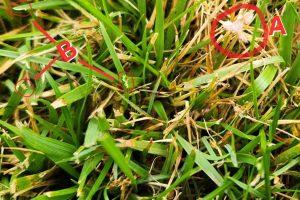The Presence of Red Thread

We recently received a call from Dana Millar of Dana Design’s—one of PJC’s long-standing customers*—asking “Why, at the end of June, is there red thread in some lawns?” One lawn in particular is outside of a gazebo area and is heavily used for outdoor summer activities. It is coastal, so humidity is especially intense and significant airflow is lacking. This lawn is also primarily rye grass, creeping fescue (fine) and Kentucky bluegrass. All three of which are species that red thread feasts on.
*It’s important to note that Dana does not mow this lawn and he has an acute understanding of lawn conditions. He’s always quick to reach out for support to gain a better understanding of how to best manage turf organically.
Environmental Conditions and Symptoms
Due to the prolonged periods of cool, rainy, and humid conditions we have experienced lately in the Northeast, you may see signs of red thread on your lawns. Red thread appears as a red thread-like structure that grows on the upper portion of infected grass. Red Thread spreads through spores and mycelium. The mycelium can be spread by mowers and foot traffic, which makes it double challenging in high use areas. These infected areas will eventually dry out and fade to a bleached turf plant that looks like straw. It’s unlikely that the disease will kill the whole turf plant, but in serious infestations it most certainly can.
Fertility
Red Thread is broadly characterized as a low-nitrogen disease. I think this is especially true if you are seeing Red Thread on Kentucky blue grass stands. Additionally—as we discussed in our Summer Fertility Blog—diseases thrive when lawns are potassium deficient. Therefore, be sure that your early-summer application has a balanced delivery of nitrogen and potassium (like our 8-0-6 or our 6-0-6 fertilizer).
Cultural Management
Mowing

B: Signs of “tearing” due to blades not being sharpened.
Red Thread enters through the top part of the leaf plant and does so easily when mower blades are not sharp. When blades aren’t sharp the turf shoot is torn rather than cut. This tearing makes the plant susceptible to disease as it struggles to heal the apex of the leaf. When possible, mow your lawns when the turf grass is dry, as wet surfaces can add to the spread of the disease. Read PJC’s Mowing Protocol Blog for additional mowing guidelines.
Clean Mower Decks when transitioning from areas that have diseases present. The worst thing you can do is spread infested areas to your other sites and create a larger issue. Taking the extra time to clean your deck between fields or lawns should be standard practice. Take special care when dealing with a lawn that already has a fungal outbreak to save time in the long run.
Reduce watering in extended rain periods.
When nature provides adequate water, the need for supplemental irrigation is significantly reduced. Therefore, turn off the irrigation system or lower watering times if the rainfall doesn’t meet the 1″ of deep watering standard that turf grass requires. If you or clients have not adjusted or turned off their irrigation based on the weather, this will likely contribute to further outbreaks. Red Thread is a fungus that reproduces by mycelium and spores. The spores need water to germinate and infect turf. Dry turf grass reduces the spread of the disease.
Over Seeding
Over Seeding is the last management practice. If you are seeing a lot of Red Thread it’s likely on a lawn that is ryegrass and fine fescue heavy. PJC Organic preaches species diversity and this situation is no different. Turf type tall fescues are a popular choice in recent years, mostly due to their drought tolerance. In this case, turf type tall fescues also tend to be more disease resistant and would be a suitable option for the adverse environmental conditions. Turf type tall fescues are tough as nails and have lower fertility needs than Kentucky bluegrass—I personally think a high rate over seed would help for years to come.
Contact PJC or call 978-432-1019 for more information on our grass seed varieties and fertilizers. We can help you manage fungal disease and weeds without the use of harmful pesticides.
